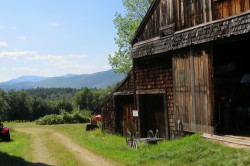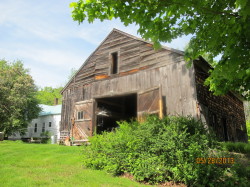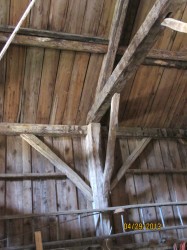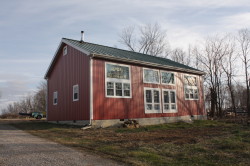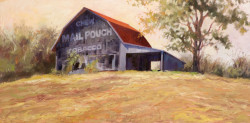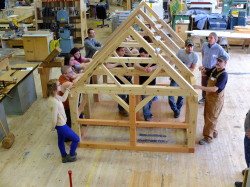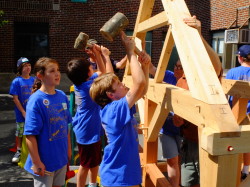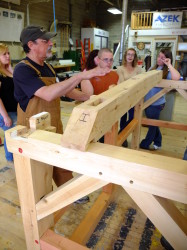This guest post was uncovered by our Past President, Charles Leik, who has an knack for finding enchanting things about barns. It has been reprinted here by permission from the October 31, 2013 The Peoples Exchange, Shipshewana, IN and the author who lives on an nearby Indiana dairy farm. Thanks for sharing your article with the NBA, Amber!
At home, I have a favorite place. Our big creaky, old barn.
It has a mingling, musty, scent of aged wood, cows, grain, sweet alfalfa hay and scratchy old coiled rope.
The barn isn’t too quiet, but it isn’t too loud, either. The barn swallows’ chirps, the young calves’ bawling, the little kittens’ meows, and the soft, whispering wind just outside join together in a perfect melody, and to me, the song of the outdoors is better than any choir or singing group anywhere. But, in addition, the barn has a nice, peaceful silence, one that is just right, and relaxing.
The barn has plenty of space where you can just lay there for a while, just thinking, seeing and breathing in everything. It has lots of spider webs, and warm sunlight pours onto the dusty floor through the holes in the creaky ancient wooden walls.
Sometimes I pack a little picnic lunch, and I’ll eat it in the haymow, sharing teeny bits of bread, or meat with the kittens that are sitting by my feet begging and they’ll start purring away like a little washing machine motor.
Inside the barn, an enormous pile of fresh grain fills the air with a pungent scent, that waves through the air filling every little nook and cranny. Children can play in the big pile for hours at a time, having the time of their life all the while. When they try to race up it, the grain crumples under their feet like sand, and every step they try to take up, they slide two steps down. Then, on the way down, instead of bothering with the grain burying their feet with every step they take, they just flop down, and make their way down as if it was a slide.
The barn is a masterpiece. There are very complicated patterns in the beams that are holding up the tall walls and high ceilings that are taller than a humongous old oak tree, like a puzzle, or a difficult crossword.
The barn was built so long ago that there aren’t any nails in the gigantically tall, wooden beams and poles. Instead, there are wooden pegs in their place.
In the barn, square bales of luscious green hay stand, piled all the way up to the high roof. They fill the air with a sweet scent. The bales are scratchy, and give you splinters if you climb them.
The floorboards in the barn croak and moan, creak and groan under my feet as I walk across them. They are wooden and dusty and covered with wheat, and straw, and hay, and grain. Without them, I would not be able to go up into the hayloft. The planks are an important piece of the barn.
In the barn, we have lots of scratchy, stale rope. In the “olden days” it was used to swing loose hay across the barn. Now, you can use it to swing yourself across the barn! You grab it, climb up a couple of straw bales, and jump. You swing way to the other side of the barn, then back again, on and on, until the big swing across the barn dwindles down to a little swing for a few feet. Then you jump off, and start all over again, until you get tired, and you think that you are done swinging for the day.
The steel cow stanchions stand vacant, empty, spider webby, and dusty like an old abandoned lot. When you turn the old, almost antique latches, they click and then go “eeeeeee”. The metal is always cool to the touch, even in the middle of the hottest summer.
The wooden calf stalls beside the stanchions are all full of young, bawling calves. The pens are stained with manure from calves of the past. Straw and sawdust, litter the cement floor, and the ground is dusty from the sawdust.
In the barn, silky spider webs hang thick. They are sticky, heavy, tangles of strong, webby, stringy lines. If you walk into them, they stick to your face, and if you try to pull them off, they cling to your finger like super glue. Spider webs make the barn look cozy.
In the barn the ceilings are tall. The filtered yellow plastic covering little of the roof lets in a few warm rays of summer. The rest of the roof is covered with aged rusty metal. When it rains, the drops leak through the many gaps and holes in the ceiling. Without the roof, the barn would be incomplete.
On the outside of the barn, there is a big cement hill leading to the haymow. The old splintery, wooden handrails at the sides are all falling off. The cement is dirty, weathered, and covered with patches of grass, weeds, and manure. The hill is hollow in the middle where we park our dirty smelly old manure spreader.
On the upper outside of the barn near the roof, there are white plastic letters that spell “THE OLD HOMESTEAD”. The letters are clean, and whenever one of them falls down or gets damaged, we replace them. They are the pride of the barn.
The barn is nice and warm in the winter, and nice and cool in the summer. It blocks out the harsh winter winds, but lets in the summer breezes. The barn is absolutely huge, but not empty.
The barn is a sleepy haven for the animals. It is musty, dirty, and almost ancient, but they don’t seem to care. They like the barn just the way it is, and so do I.
On the outside, the old peeling red paint on the barn is just enough for you to feel like you have been inside it about a million times, and that you have known it all your life. The barn is already over a hundred years old, and still, the rough weathered, sturdy wood stoutly, stands tall. The barn is my most favorite place in the world.
At home, I have a favorite place. Our big, creaky, old barn.

